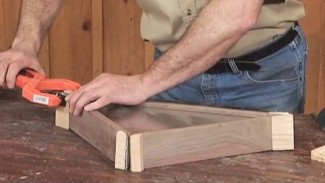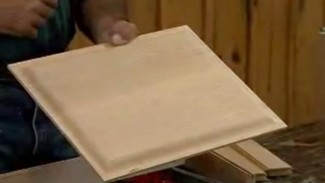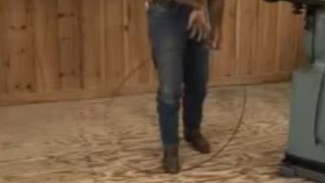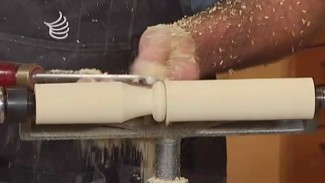You’ve seen, and maybe made, end grain cutting boards. They typically are made from a variety of hardwoods like walnut, maple, and cherry. That mix gives you kind of a checkerboard pattern of colors when the cutting board is complete. We’re going to do things a little differently on this project. Instead of using a bunch of different hardwood species, the entire end grain cutting board is made from one slab of wood. The result is visually amazing! You’ll have a cutting board that’s FULL of end grain bookmatches.
Material choice
It’s best to use close-grained hardwoods for any cutting board. Close-grained means non-porous material. For example, red oak is a bad cutting board choice because of its porosity. Maple, walnut, and cherry (and many other hardwoods) are good choices.
Crosscutting your board
When you crosscut the slab, you’ll save a lot of sanding time by using a good-quality crosscut blade now. A good blade will leave your end grain cuts smooth, which means less sanding on the cutting board. Less sanding is always good.
Glue choice
Titebond III is a great choice for cutting boards. It’s waterproof and FDA-approved for food-related projects. If you have any tiny voids you need to fill, like I did, CA glue is a good choice for filling those.
Finishing
Mineral oil works very well as a food-safe finish. If, over time, the cutting board gets a little “tired” looking, refresh it with another coat of oil.
Make a traditional end grain cutting board
If you want to make a multi-species, multi-colored cutting board, we’ve got you covered with a complete how-to video on the topic.
More info
For more information on Titebond products, visit the company’s website or call (800) 669-4583.





Why not use the planer for the final flattening? Also, the finish was too dark to see well in the video. Great project!
It is dangerous to run end grain glue ups through a planer. They can explode in dramatic fashion and cause kickback as well as damage to the planer.
Paul
Good looking board. Probably my next board. Just have to decide which wood to use. When I make an end grain board I glue an additional 5-6″ sacrificial board on each end, plane them flat, and then cut off the sacrificial section. This eliminates tear out and is a lot quicker than sanding. Again, pretty board.
You seem to have some sapwood left on the two outside rips. Is this not a problem?
I’m surprised you didn’t show off using the sliding crosscut table you have installed there. I find that is invaluable for those bulky and ‘dicey’ crosscuts.
I believe it makes an amazing pattern and I could almost see it. Holding the oiled board up to the camera would have allowed a much better view. Thank you for a great idea, I will be having a go myself.
You only showed rotating the reference marks rotated out. I’m curious what it would have looked like with reference marks rotated in… could you tear it apart and show the difference? LOL… Another great video!
It’s fun to experiment and try different patterns. It would have looked very different, and probably also very cool.
Nice video! Looks like you flipped that last strip the wrong way. Crazy how one minor boo-boo can send the whole project to the scrap bin!
When you said from fence to the outside of the blade for measurement, do you consider the outside of the blade to be the farthest from the fence. New to creating want be sure I am understanding you correctly
Thank You
Yes, measure from the fence to the extreme of the blade that’s furthest from the fence.
Excellent video, and I love the end result! Even better, super excited to see how you took a single slab of live edge and pulled off a decent-sized cutting board. I’m finishing my first (a combination of walnut and maple), and used longer and thinner boards. I love the thickness of the finished product and being able to use a single source, and I’m adding this to my list of near-term projects.
One question, in two parts: how long was the original slab? And, what were the approximate dimensions on the final cutting board?
Thanks for all of your great work and tutorials. Happy to be a new member and look forward to learning lots more!
I don’t have the finished board anymore. It became a wedding gift. But you can estimate the finished size.
Say the slab is 1-1/2” thick and 20” long. I’d you crosscut it into 2” strips you’ll have 9 strips. When you rotate them end grain up you’ll have a 13-1/2” long board, 2” thick.
Could you post a picture of the completed board it was hard to see the grain patterns on the video. Thanks!
Thanks. Nice video. Why not use a planner to start finishing the board after the last glue up?
It’s best not to plane end grain. The end grain can catch, and things go really badly…. https://www.wwgoa.com/video/running-end-grain-cutting-board-planer/
I understand now and it makes sense to me. Thanks George.
why couldn’t you use your drum sander instead of a belt sander?
That’d be a GREAT way to go. Because not everyone owns a drum sander I used the belt sander here.